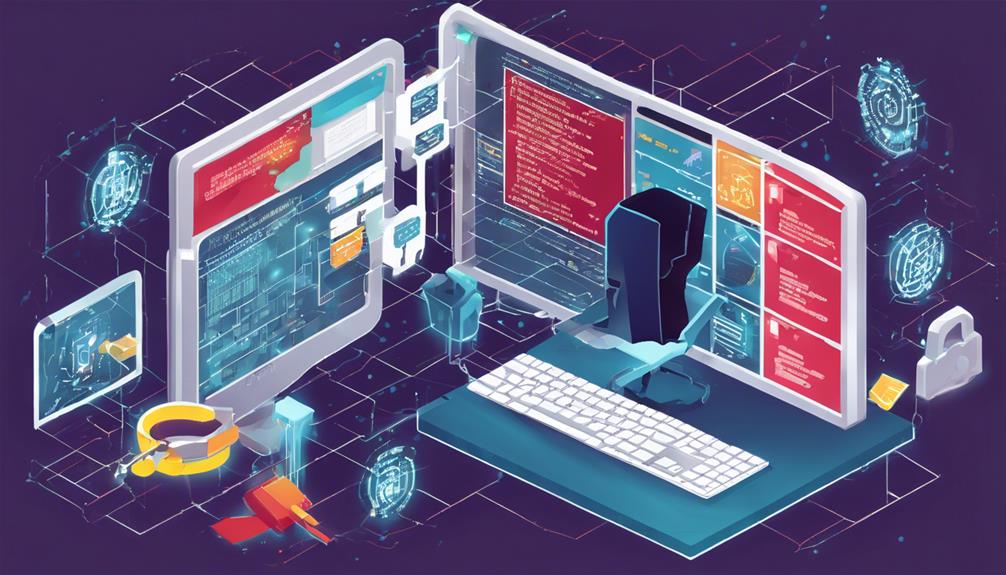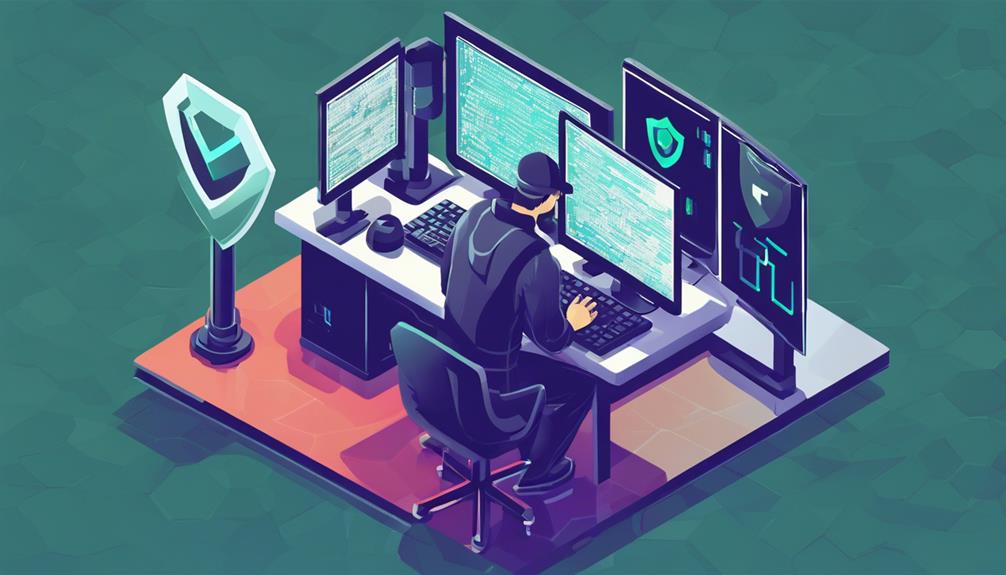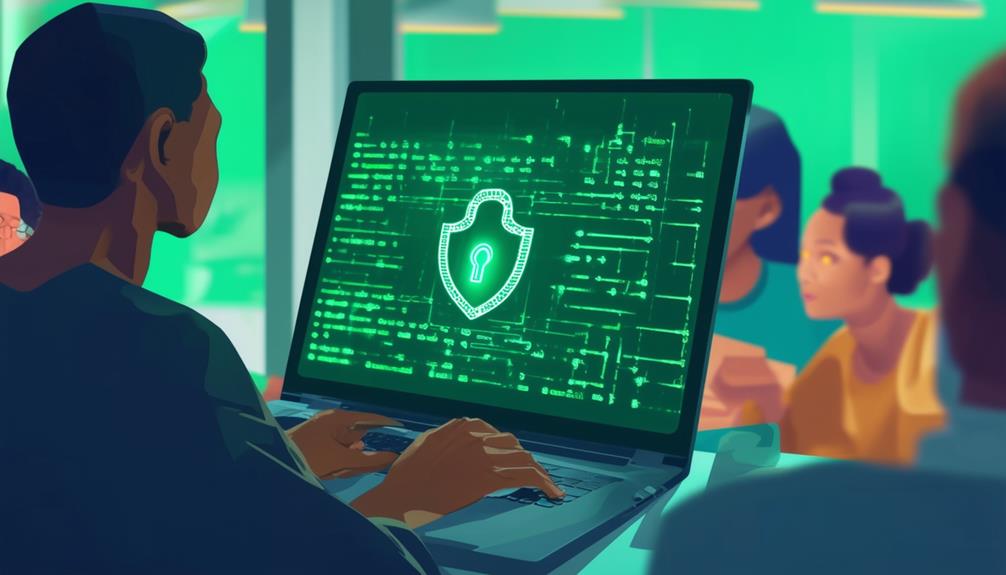Ethical hacking videos on vulnerability analysis are essential for detecting cybersecurity weaknesses. These videos offer practical insights into identifying and addressing vulnerabilities effectively. By learning from these resources, one can acquire vital skills in recognizing and mitigating security threats. Understanding how to detect vulnerabilities is fundamental in fortifying cybersecurity defenses and preventing potential breaches. Explore further into these videos to enhance your knowledge and proficiency in maintaining a robust security posture.
Key Takeaways
- Ethical hacking videos demonstrate vulnerability analysis techniques
- Learn to identify and mitigate vulnerabilities effectively
- Practical demonstrations aid in understanding cybersecurity risks
- Videos cover tools like Nessus and Wireshark for vulnerability detection
- Enhance skills in detecting security weaknesses through video tutorials
Importance of Vulnerability Analysis
Conducting vulnerability analysis plays an essential role in fortifying cybersecurity defenses by systematically identifying and addressing potential security weaknesses. In the domain of information security, vulnerability analysis serves as a cornerstone for organizations aiming to safeguard their systems, networks, and applications.
By leveraging the expertise of ethical hackers, companies can proactively detect and mitigate vulnerabilities before malicious actors exploit them. This proactive approach not only helps in evaluating the severity of vulnerabilities but also aids in prioritizing them for remediation, thereby enhancing the overall security posture.
Moreover, vulnerability analysis provides organizations with a thorough understanding of their risk exposure, enabling them to implement effective security measures tailored to their specific needs. Regular vulnerability analysis is vital for staying abreast of evolving cyber threats and reducing the likelihood of security breaches.
Embracing vulnerability analysis as a fundamental practice empowers organizations to strengthen their cyber defenses and protect sensitive data from potential attacks.
Common Vulnerabilities in Networks

Among the significant threats to network security are common vulnerabilities that can expose organizations to various risks and cybersecurity breaches. Misconfigured firewalls, unpatched software, weak passwords, and unencrypted data transmissions are prevalent vulnerabilities in networks. These weaknesses can lead to unauthorized access, data breaches, denial of service attacks, and interception of network traffic.
To address these risks, vulnerability scanning, penetration testing, and the use of vulnerability assessment tools like Nessus and OpenVAS are vital. These tools help in identifying weaknesses in network configurations and services, allowing organizations to proactively address potential security gaps.
Attackers can exploit network vulnerabilities to gain access to sensitive information, compromise network integrity, and disrupt services. Regular vulnerability assessments and patch management are essential practices to mitigate vulnerabilities in networks and enhance overall security posture.
Tools for Vulnerability Detection

Detection tools commonly used for identifying vulnerabilities in networks and systems include Nessus Professional, OpenVAS, Qualys Vulnerability Management System, Wireshark, and GFI Languard. These tools are essential for certified ethical security professionals to conduct thorough vulnerability assessments and secure networks effectively.
- Nessus Professional: Known for its thorough vulnerability scanning capabilities and extensive database of known vulnerabilities.
- Qualys Vulnerability Management System: Provides a centralized platform for managing vulnerabilities across different operating systems and devices.
- Wireshark: A powerful network protocol analyzer that helps security professionals capture and analyze network traffic to identify potential security weaknesses.
Security professionals rely on these tools to detect vulnerabilities, prioritize remediation efforts, and ensure the overall security posture of systems and networks.
Understanding Security Weaknesses

Security weaknesses, often stemming from vulnerabilities in system design or implementation, pose significant risks to the overall integrity of systems and data. These weaknesses can result from a variety of factors such as software misconfigurations, poor programming practices, or even end-user actions. Ethical hackers play an essential role in the topic of vulnerability analysis by identifying and addressing these security weaknesses before they can be exploited by malicious actors.
Understanding security weaknesses is vital for maintaining the confidentiality and integrity of systems and data.
Vulnerability analysis involves evaluating the impact, likelihood, and severity of potential security breaches in a system. By thoroughly understanding security weaknesses, organizations can proactively strengthen their defenses and prevent unauthorized access to sensitive information.
Ethical hacking techniques are employed to simulate real-world cyber threats and identify vulnerabilities that could be exploited by attackers. Through this process, security professionals can take proactive measures to enhance the security posture of systems and prevent potential data breaches.
Techniques for Vulnerability Assessment

Techniques for vulnerability assessment encompass a range of methods, from passive scanning to active testing. Utilizing tools like Qualys, OpenVAS, and Nessus aids in pinpointing system weaknesses.
Tools for Vulnerability Assessment
Commonly employed in the field of cybersecurity, various advanced tools are utilized for conducting thorough vulnerability assessments to identify and mitigate potential security risks. These tools play an essential role in ensuring the protection of networks and systems from cyber threats.
Here are three key tools for vulnerability assessment:
- Qualys Vulnerability Management System: This tool offers continuous monitoring, reporting, and prioritization of vulnerabilities across networks, making it a popular choice for organizations seeking inclusive vulnerability management solutions.
- OpenVAS (Open Vulnerability Assessment System): As an open-source vulnerability scanner, OpenVAS assists in identifying security issues in servers and network devices, providing valuable insights into potential vulnerabilities that need to be addressed.
- Nessus Professional: Widely used for vulnerability scanning, Nessus Professional offers in-depth vulnerability analysis, compliance checks, and customizable reporting options, equipping cybersecurity professionals with the tools needed to assess and remediate vulnerabilities effectively.
Common Vulnerability Identification
Network scanning is a foundational method employed in vulnerability assessment to identify active hosts, open ports, and services running on a network.
Port scanning complements this by discovering open ports, services, and potential vulnerabilities on a target system.
Vulnerability scanning takes it a step further by using tools like Nessus or OpenVAS to pinpoint weaknesses in software configurations or missing patches. This method is essential for staying ahead of potential threats.
Penetration testing, on the other hand, simulates real-world attacks to uncover vulnerabilities and evaluate the security stance of a system or network.
By combining these techniques, cybersecurity professionals can gain a thorough understanding of the potential vulnerabilities present, allowing them to proactively address and strengthen their defenses.
Regularly utilizing these common vulnerability identification techniques can greatly enhance the security posture of any organization or individual's network infrastructure.
Risk Mitigation Strategies
Risk mitigation strategies in vulnerability assessment encompass various proactive measures aimed at reducing security risks and safeguarding systems against potential threats. These strategies are essential for maintaining the integrity and confidentiality of sensitive information.
Here are three key risk mitigation strategies:
- Patch Management: Keeping software and systems up to date with the latest security patches helps close known vulnerabilities that attackers could exploit.
- Network Segmentation: Dividing networks into smaller segments with restricted access controls limits the spread of threats and reduces the impact of potential breaches.
- Access Control: Implementing strict access controls, including least privilege principles and multi-factor authentication, guarantees that only authorized users can access critical systems and data.
Real-world Vulnerability Scenarios

Real-world vulnerability scenarios provide essential simulations for ethical hackers to enhance their skills in identifying and exploiting security weaknesses. These scenarios mimic real-life situations where hackers attempt to breach systems using common vulnerabilities like SQL injection, cross-site scripting (XSS), and insecure direct object references.
Ethical hackers leverage tools such as Metasploit, Burp Suite, and Nikto to analyze vulnerabilities and exploit them in controlled environments. The scenarios may involve unauthorized access to systems, compromise of sensitive data, or disruption of services, allowing ethical hackers to practice their skills in a safe setting.
Engaging with real-world vulnerability scenarios is vital for ethical hackers to hone their abilities in identifying, evaluating, and mitigating security weaknesses effectively. By practicing in these simulated environments, ethical hackers can develop a deeper understanding of potential cyber threats and how to counteract them, ultimately strengthening overall cybersecurity defenses.
Steps to Detect Vulnerabilities

Detecting vulnerabilities in systems involves utilizing specialized tools like vulnerability scanning software such as Nessus or OpenVAS to automatically search for security weaknesses.
Additionally, manual code reviews are essential to thoroughly examine the source code for potential vulnerabilities that automated tools might miss.
Vulnerability Scanning Tools
Utilizing advanced vulnerability scanning tools is essential for organizations seeking to proactively identify and address security weaknesses within their networks and applications. These tools play a vital role in enhancing the overall security posture by detecting vulnerabilities that malicious actors could exploit.
Here are three key points about vulnerability scanning tools:
- Active Assessments: Tools like Qualys Vulnerability Management System and Nessus Professional conduct active evaluations by scanning systems for vulnerabilities, evaluating risks, and providing detailed reports for remediation.
- Identifying Weaknesses: Vulnerability scanning involves spotting vulnerabilities in network devices, operating systems, and applications, allowing organizations to prioritize security measures effectively.
- Preventing Cyber Attacks: Regular vulnerability scans help organizations reduce risks and prevent potential cyber attacks by addressing vulnerabilities proactively.
Manual Code Review
Conducting thorough manual code reviews is a critical practice in identifying vulnerabilities and enhancing the security of software applications. By scrutinizing source code line by line, developers can uncover potential security issues that automated tools might miss. The manual code review process involves various steps, including examining for common coding errors, evaluating input validation mechanisms, and identifying insecure coding practices. Detecting vulnerabilities such as SQL injection, cross-site scripting (XSS), and buffer overflows through manual review is essential for fortifying the resilience of software against malicious attacks.
To illustrate the significance of manual code review, here is a table showcasing the key steps involved in this meticulous process:
| Manual Code Review Steps |
|---|
| 1. Reviewing source code line by line |
| 2. Identifying common coding mistakes |
| 3. Analyzing input validation |
| 4. Checking for insecure coding practices |
| 5. Uncovering hidden vulnerabilities |
Skilled code reviewers play a pivotal role in ensuring that software applications are robust and secure, safeguarding them against potential security breaches.
Best Practices in Cybersecurity

Implementing a thorough cybersecurity strategy is paramount to safeguarding organizational assets against evolving cyber threats. To guarantee robust protection, organizations should adhere to best practices in cybersecurity:
- Conduct regular vulnerability assessments to identify and address potential weaknesses in systems and software.
- Enforce strict patch management procedures to promptly apply security updates and patches to mitigate vulnerabilities.
- Implement network segmentation to limit the impact of a potential breach and prevent lateral movement within the network.
Ethical Hacking Case Studies

Exploring real-world ethical hacking case studies reveals practical insights into the detection and exploitation of vulnerabilities for security testing purposes. These studies offer valuable examples of how ethical hackers identify weaknesses in systems and networks, demonstrating the importance of thorough vulnerability analysis. By examining these cases, aspiring security professionals can enhance their understanding of cybersecurity risks and strategies for mitigation. Here is a table summarizing key points from ethical hacking case studies:
| Case Study | Vulnerabilities Found | Risks Identified | Remediation Steps | Key Takeaways |
|---|---|---|---|---|
| Banking System Hack | SQL Injection, Weak Authentication | Financial Data Theft, Unauthorized Access | Patching SQL Injection Vulnerabilities, Implementing Multi-Factor Authentication | Importance of Secure Coding Practices |
| IoT Device Breach | Default Passwords, Lack of Encryption | Unauthorized Device Control, Data Interception | Changing Default Passwords, Encrypting Data Transmission | Significance of IoT Security Measures |
| Website Defacement | Cross-Site Scripting (XSS) | Defamation, Loss of Trust | Input Sanitization, Regular Security Audits | Need for Web Application Security |
| Social Engineering Attack | Phishing, Impersonation | Data Breach, Identity Theft | Employee Training, Implementing Multi-Layered Authentication | Human Factor in Security |
| Ransomware Infection | Unpatched Software, Lack of Backups | Data Encryption, Financial Loss | Regular Updates, Backup Implementation | Importance of Cyber Hygiene |
Enhancing Security Measures

Enhancing security measures involves utilizing various security assessment techniques to detect vulnerabilities and mitigate risks effectively.
By implementing robust vulnerability detection methods and employing strategic risk mitigation strategies, organizations can enhance their overall security posture.
These measures are essential for safeguarding sensitive data, protecting against cyber threats, and maintaining a secure digital environment.
Security Assessment Techniques
Conducting thorough security assessments is paramount for organizations looking to strengthen their defense against potential cyber threats. Security assessment techniques play a vital role in enhancing security measures by identifying vulnerabilities, weaknesses, and potential risks within systems.
To achieve this goal effectively, organizations employ various assessment methods, including:
- Penetration Testing: Simulates real-world cyber attacks to evaluate the security of systems, applications, and networks.
- Vulnerability Scanning: Automated scans that identify known vulnerabilities within an organization's IT infrastructure.
- Risk Assessments: Evaluate the likelihood and impact of potential security risks to prioritize mitigation efforts.
Vulnerability Detection Methods
To fortify organizational defenses against cyber threats, implementing effective vulnerability detection methods is vital. These methods involve utilizing tools like vulnerability scanners, network sniffers, and penetration testing to identify weaknesses in systems. Enhancing security measures includes conducting regular vulnerability assessments, patching software, and configuring firewalls to mitigate vulnerabilities. Common techniques for vulnerability detection encompass analyzing network traffic, examining system logs, and conducting security audits. Ethical hackers leverage automated tools and manual techniques to pinpoint vulnerabilities in networks, applications, and systems. Additionally, implementing intrusion detection systems, conducting code reviews, and enforcing robust access controls are essential for detecting and addressing vulnerabilities.
| Vulnerability Detection Methods | Description | Example Tools |
|---|---|---|
| Vulnerability Scanners | Identify security weaknesses in systems | Nessus, OpenVAS |
| Network Sniffers | Monitor and analyze network traffic | Wireshark, tcpdump |
| Penetration Testing | Simulate cyber attacks to find vulnerabilities | Metasploit, Burp Suite |
Risk Mitigation Strategies
How can organizations effectively fortify their defenses against cyber threats through proactive risk mitigation strategies?
To enhance security measures and reduce vulnerabilities, organizations can implement the following key strategies:
- Patch Management: Regularly updating software and systems with the latest security patches can help prevent known vulnerabilities from being exploited by attackers.
- Network Segmentation: Dividing networks into smaller segments with restricted access can limit the impact of a potential breach and prevent lateral movement by cybercriminals.
- Access Control: Enforcing strict access control policies, such as least privilege principles and multifactor authentication, can minimize the risk of unauthorized access to sensitive data and systems.
Frequently Asked Questions
How Do Hackers Scan for Vulnerabilities?
Hackers scan for vulnerabilities by employing specialized tools like Nmap, Nessus, and OpenVAS to identify weaknesses within networks, systems, and applications. This process involves actively probing for security holes, misconfigurations, and exploitable weaknesses.
What Are the Four Steps to Vulnerability Analysis?
Beginning the journey for digital fortification, vulnerability analysis unfolds in four pivotal steps: pre-assessment, vulnerability assessment, assessment activities, and post-assessment. These steps form a strategic shield, fortifying networks against potential breaches.
What Are the Five Types of Vulnerability Assessment?
Vulnerability assessments encompass passive, active, host-based, network-based, and application-based evaluations. Passive monitoring observes network traffic for vulnerabilities. Active scanning actively seeks vulnerabilities. Host-based focuses on individual devices. Network-based assesses network infrastructure. Application-based targets software weaknesses.
What Is Called Periodic Assessment of Security Vulnerability in Computer Systems?
What is called periodic assessment of security vulnerability in computer systems? Regular security vulnerability assessments involve scanning networks and systems to identify weaknesses, prioritize security measures, and protect sensitive data against potential cyber threats.
Conclusion
In the world of cybersecurity, vulnerability analysis is like a detective searching for clues to protect our digital assets. By understanding common vulnerabilities, using the right tools, and following best practices, we can enhance our security measures and prevent cyber attacks.
Just like a skilled investigator, ethical hackers play an important role in safeguarding our online world, ensuring a safer digital environment for all.









